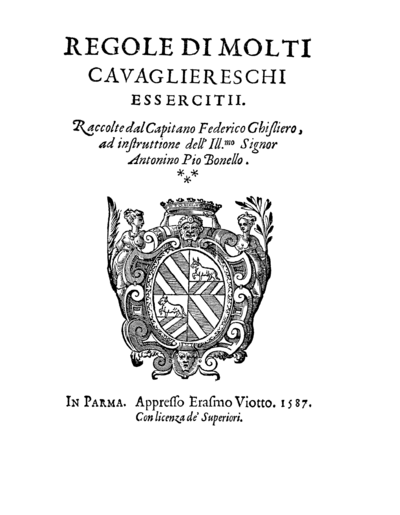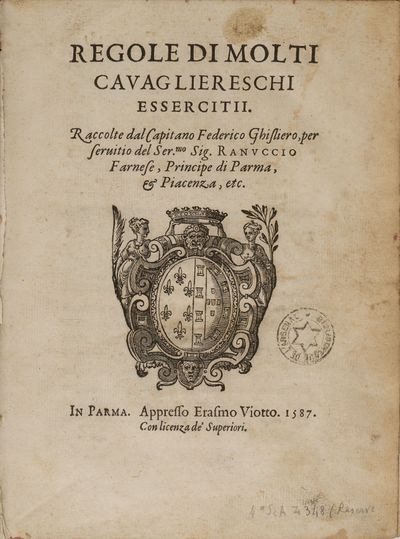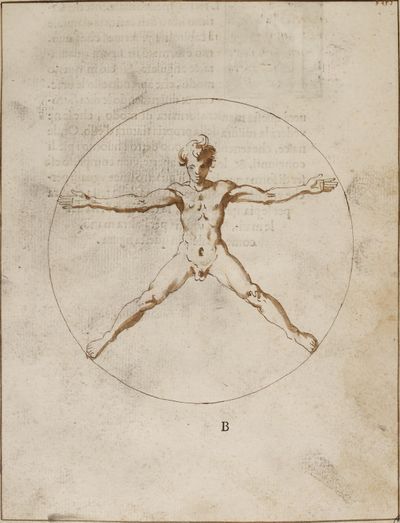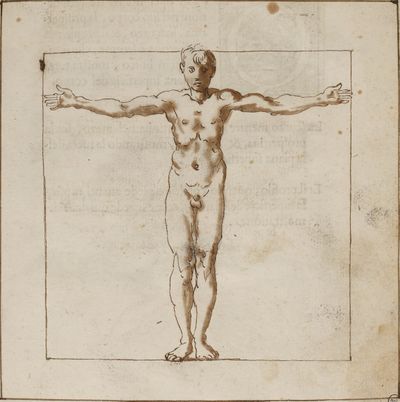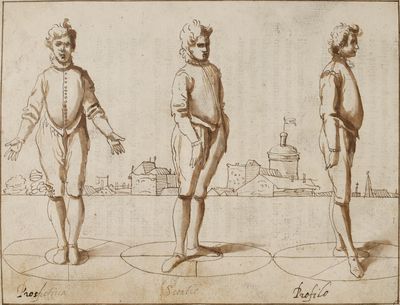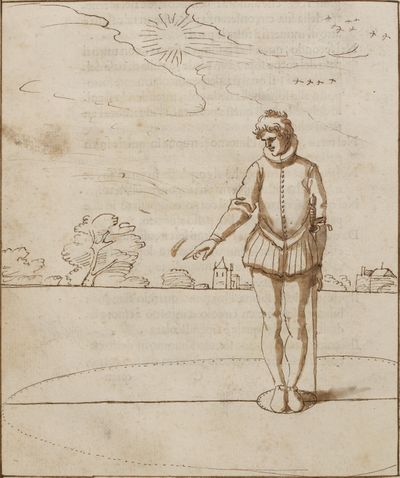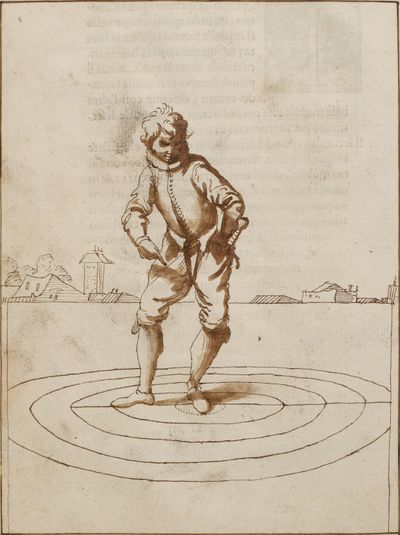|
|
You are not currently logged in. Are you accessing the unsecure (http) portal? Click here to switch to the secure portal. |
Difference between revisions of "Federico Ghisliero"
| Line 117: | Line 117: | ||
|- | |- | ||
| | | | ||
| − | | <p>''And while we can make this art<ref>When ‘this art’ or ‘the art’ is referenced it means the art of fencing. [More expansively the | + | | <p>''And while we can make this art<ref>When ‘this art’ or ‘the art’ is referenced it means the art of fencing. [More expansively the ''ars militari'' (military arts) or for the more classical, the Arts of Mars, of which swordsmanship falls within.] [note from Henry Fox]</ref> profit on a thousand other occasions, if only it delivers the following two benefits at the same time it could be considered worthy, and we can do it very well through practicing this art: firstly vigour and robustness of the soul and body; the other which should not be taken lightly, and is the principle reason for this study to be pursued, is being able to defend against any insult against your person.''<ref>Further justification by demonstration of the benefits to those who practice the art in question, also common, especially referring to defense of the person and the realm. [note from Henry Fox]</ref></p> |
| {{section|Page:Regole di molti cavagliereschi essercitii (Federico Ghisliero) 1587.pdf/11|3|lbl=+ⅲ.3}} | | {{section|Page:Regole di molti cavagliereschi essercitii (Federico Ghisliero) 1587.pdf/11|3|lbl=+ⅲ.3}} | ||
| Line 251: | Line 251: | ||
|} | |} | ||
{{master subsection end}} | {{master subsection end}} | ||
| − | + | == Temp == | |
{{master subsection begin | {{master subsection begin | ||
| title = Chapter 2 | | title = Chapter 2 | ||
| Line 276: | Line 276: | ||
* the fifth is the place where we work; | * the fifth is the place where we work; | ||
* the sixth is the manner in which we work; | * the sixth is the manner in which we work; | ||
| − | * the seventh is the end [the reason, motivation] for which we work.<ref>This is an application of Aristotle’s Causes, in some ways more easily explained due to the application of the sword (though this could be my fencer’s brain), especially as it develops. Ghisliero uses seven rather than four as Aristotle does, or at least using the same method of explanation. [Henry Fox]</ref> | + | * the seventh is the end [the reason, motivation] for which we work.<ref>This is an application of Aristotle’s Causes, in some ways more easily explained due to the application of the sword (though this could be my fencer’s brain), especially as it develops. Ghisliero uses seven rather than four as Aristotle does, or at least using the same method of explanation. [Henry Fox]</ref> |
| {{section|Page:Regole di molti cavagliereschi essercitii (Federico Ghisliero) 1587.pdf/20|2|lbl=6.2}} | | {{section|Page:Regole di molti cavagliereschi essercitii (Federico Ghisliero) 1587.pdf/20|2|lbl=6.2}} | ||
| Line 319: | Line 319: | ||
|- | |- | ||
| [[File:Ghisliero 02.jpg|400px|center]] | | [[File:Ghisliero 02.jpg|400px|center]] | ||
| − | | <p>'''I'''n Chapter 17 of Pliny’s<ref>The Elder.</ref> seventh book of natural history he writes,<ref>''Scriue'' is Catalan. Modern Italian is ''lui scrive''.</ref> man is a figure of squares and angles and by opening up your arms and by stretching your fingers you will see from this shape that you can measure the size of your height. In the same way by keeping the man’s feet together and open arms are included in the square form of four equal lines, because: | + | | <p>'''I'''n Chapter 17 of Pliny’s<ref>The Elder.</ref> seventh book of natural history he writes,<ref>''Scriue'' is Catalan. Modern Italian is ''lui scrive''.</ref> man is a figure of squares and angles and by opening up your arms and by stretching your fingers you will see from this shape that you can measure the size of your height. In the same way by keeping the man’s feet together and open arms are included in the square form of four equal lines, because: the first line passes across the top of the head, the next line passes through where the feet touch the floor, the third line passes through one of the hands and the last line passes through the other hand, as shown in this figure.</p> |
| {{pagetb|Page:Regole di molti cavagliereschi essercitii (Federico Ghisliero) 1587.pdf|24|lbl=10}} | | {{pagetb|Page:Regole di molti cavagliereschi essercitii (Federico Ghisliero) 1587.pdf|24|lbl=10}} | ||
| Line 535: | Line 535: | ||
|- | |- | ||
| | | | ||
| − | | <p>And there are three movements, two simple – the straight and the circular – | + | | <p>And there are three movements, two simple – the straight and the circular – and the third a compound of these two, which serves the compound line.</p> |
| {{section|Page:Regole di molti cavagliereschi essercitii (Federico Ghisliero) 1587.pdf/36|3|lbl=22.3}} | | {{section|Page:Regole di molti cavagliereschi essercitii (Federico Ghisliero) 1587.pdf/36|3|lbl=22.3}} | ||
| Line 650: | Line 650: | ||
| | | | ||
| | | | ||
| − | * in the second you can take it flat with the palm of the hand towards the ground. And this is done to have it seem lighter; since the hand with the arm in this state works almost as a support for the body, which makes the weight of the sword seem lighter; but in this way it will not cut and changes the lines in play, which is completely imperfect. | + | * in the second you can take it flat with the palm of the hand towards the ground. And this is done to have it seem lighter; since the hand with the arm in this state works almost as a support for the body, which makes the weight of the sword seem lighter; but in this way it will not cut and changes the lines in play, which is completely imperfect. |
| {{section|Page:Regole di molti cavagliereschi essercitii (Federico Ghisliero) 1587.pdf/39|3|lbl=25.3}} | | {{section|Page:Regole di molti cavagliereschi essercitii (Federico Ghisliero) 1587.pdf/39|3|lbl=25.3}} | ||
| Line 688: | Line 688: | ||
|- | |- | ||
| | | | ||
| − | | | + | | <p>The defensive instrument, which I consider to be the dagger, has a resistant body; that has the pleasure of defending the body of the man; and can be held in the hand in three ways:</p> |
| + | * in the first, it is held flat in the hand, with the large finger in the middle of the blade, and by dividing the body into two parts, with a semi-circular movement it defends the right side, and with another semi-circular movement it defends the left side. And therefore it must be placed in presence in proportion; with these movements he makes the said defenses which have a lot of imperfections [flaws]: | ||
| + | ** one is that that hand is subjected the offense: | ||
| + | ** the other is that, even if the last point is only a small circle, the whole line of the dagger forms an angle with that of the arm, through which many lines [of attack] can enter | ||
| + | ** in addition, it is subject to many disadvantages, both inside and outside, and both below and above. | ||
| | | | ||
{{section|Page:Regole di molti cavagliereschi essercitii (Federico Ghisliero) 1587.pdf/40|6|lbl=26.6|p=1}} {{section|Page:Regole di molti cavagliereschi essercitii (Federico Ghisliero) 1587.pdf/41|1|lbl=27.1|p=1}} | {{section|Page:Regole di molti cavagliereschi essercitii (Federico Ghisliero) 1587.pdf/40|6|lbl=26.6|p=1}} {{section|Page:Regole di molti cavagliereschi essercitii (Federico Ghisliero) 1587.pdf/41|1|lbl=27.1|p=1}} | ||
| Line 695: | Line 699: | ||
| | | | ||
| | | | ||
| + | * In the second, you hold the dagger in your hand, bringing it closer to the right parts [side]; and only try to beat it outwards so that it prevents the attack from reaching the body. This is false, because instead of covering it, he uncovers it; and it is very violent. Besides, every time that the fist moves a little at an angle the dagger, thus held, will not prevent the sword from entering, and it too is subjected to deception. | ||
| {{section|Page:Regole di molti cavagliereschi essercitii (Federico Ghisliero) 1587.pdf/41|2|lbl=27.2}} | | {{section|Page:Regole di molti cavagliereschi essercitii (Federico Ghisliero) 1587.pdf/41|2|lbl=27.2}} | ||
| Line 700: | Line 705: | ||
| | | | ||
| | | | ||
| + | * In the third and last one (which is the perfect one) the dagger is held in the hand in such a way that one can cleave with it if necessary: and from here, with natural movements, the body is defended by covering it: which is thus always kept free from offense and is not subjected to deception. | ||
| | | | ||
{{section|Page:Regole di molti cavagliereschi essercitii (Federico Ghisliero) 1587.pdf/41|3|lbl=27.3|p=1}} {{section|Page:Regole di molti cavagliereschi essercitii (Federico Ghisliero) 1587.pdf/42|1|lbl=28.1|p=1}} | {{section|Page:Regole di molti cavagliereschi essercitii (Federico Ghisliero) 1587.pdf/41|3|lbl=27.3|p=1}} {{section|Page:Regole di molti cavagliereschi essercitii (Federico Ghisliero) 1587.pdf/42|1|lbl=28.1|p=1}} | ||
| Line 705: | Line 711: | ||
|- | |- | ||
| | | | ||
| − | | | + | | <p>In addition to this defending line, it will always dominate the opposing sword; and with its natural motions it will beat it, always helping the lines to their declination: because very little force adds new motion to any weight, which moves first.</p> |
| {{section|Page:Regole di molti cavagliereschi essercitii (Federico Ghisliero) 1587.pdf/42|2|lbl=28.2}} | | {{section|Page:Regole di molti cavagliereschi essercitii (Federico Ghisliero) 1587.pdf/42|2|lbl=28.2}} | ||
|- | |- | ||
| | | | ||
| − | | | + | | <p>Nevertheless, the last third of the sword will be beaten, since it is the ''debole''<ref>''Debole'' refers to the half of the blade from tip of the blade to one third down towards the hilt.</ref> in this respect: although when it attacks, it is the strongest or best. This is because, moving with violent motion, the first part of any inanimate thing is easy to move to the other part, which must be understood in this way: since everything is continuously moving, it is very easy to make it move obliquely from those ends to which the mover is attached, since the other end is transported with great speed.</p> |
| {{section|Page:Regole di molti cavagliereschi essercitii (Federico Ghisliero) 1587.pdf/42|3|lbl=28.3}} | | {{section|Page:Regole di molti cavagliereschi essercitii (Federico Ghisliero) 1587.pdf/42|3|lbl=28.3}} | ||
|- | |- | ||
| | | | ||
| − | | | + | | <p>And just as in the case of things which are thrown or pulled, the motion weakens in the end; so the movement continues to be weaker at the ''debole'' and the resistance is less. And on that part [of the blade] things are more easily pushed as there is greater weakness, and therefore less resistance, which is undoubtedly in its end.</p> |
| {{section|Page:Regole di molti cavagliereschi essercitii (Federico Ghisliero) 1587.pdf/42|4|lbl=28.4}} | | {{section|Page:Regole di molti cavagliereschi essercitii (Federico Ghisliero) 1587.pdf/42|4|lbl=28.4}} | ||
|- | |- | ||
| | | | ||
| − | | | + | | <p>The dagger is a defensive instrument which should form a straight line with the arm; and the same should form a right angle with the surface of the body. And at this point, the view of the man should pass through the ''forte''<ref>''Forte'' refers to the first third of the blade from the hilt to towards the tip.</ref> of the dagger, with the [true] edge over the ''debole'' of the enemy’s sword.<ref>Placing the edge over the ''debole'' like this is the basis of the Italian gaining ''stringere'' of the sword, or the Spanish ''atajo''. It's used to close and control the line to prevent the opponent from hitting us. [Note by Táriq ibn Jelal ibn Ziyadatallah al-Naysábúrí]</ref> |
| | | | ||
{{section|Page:Regole di molti cavagliereschi essercitii (Federico Ghisliero) 1587.pdf/42|5|lbl=28.5|p=1}} {{section|Page:Regole di molti cavagliereschi essercitii (Federico Ghisliero) 1587.pdf/43|1|lbl=29.1|p=1}} | {{section|Page:Regole di molti cavagliereschi essercitii (Federico Ghisliero) 1587.pdf/42|5|lbl=28.5|p=1}} {{section|Page:Regole di molti cavagliereschi essercitii (Federico Ghisliero) 1587.pdf/43|1|lbl=29.1|p=1}} | ||
| Line 726: | Line 732: | ||
|- | |- | ||
| | | | ||
| − | | | + | | <p>Working in this way with the dagger, we will by necessesity use our sword to cut through the circle of the enemy’s body.</p> |
| {{section|Page:Regole di molti cavagliereschi essercitii (Federico Ghisliero) 1587.pdf/43|2|lbl=29.2}} | | {{section|Page:Regole di molti cavagliereschi essercitii (Federico Ghisliero) 1587.pdf/43|2|lbl=29.2}} | ||
|- | |- | ||
| | | | ||
| − | | | + | | <p>And because the dagger always has to dominate the opponant’s sword, we must ensure that when we raise the sword to our enemy, we raise the dagger so that, always passing through it, we see the sword dominated from the inside [line].</p> |
| {{section|Page:Regole di molti cavagliereschi essercitii (Federico Ghisliero) 1587.pdf/43|3|lbl=29.3}} | | {{section|Page:Regole di molti cavagliereschi essercitii (Federico Ghisliero) 1587.pdf/43|3|lbl=29.3}} | ||
|- | |- | ||
| | | | ||
| − | | | + | | <p>The dagger strikes in straight lines; in oblique lines it removes lines; and in angular lines it strikes the edge. And in three ways it strikes the enemy’s line:</p> |
| + | * in the first by will; | ||
| + | * in the second by necessity; | ||
| + | * in the third by progress; in the third it strikes inward, causing the longest wound. | ||
| {{section|Page:Regole di molti cavagliereschi essercitii (Federico Ghisliero) 1587.pdf/43|4|lbl=29.4}} | | {{section|Page:Regole di molti cavagliereschi essercitii (Federico Ghisliero) 1587.pdf/43|4|lbl=29.4}} | ||
|- | |- | ||
| | | | ||
| − | | | + | | <p>If necessary, the sword is not beaten, but only by existing at the attack does he escape with the body, causing the attack to turn the false edge towards the ground.</p> |
| {{section|Page:Regole di molti cavagliereschi essercitii (Federico Ghisliero) 1587.pdf/43|5|lbl=29.5}} | | {{section|Page:Regole di molti cavagliereschi essercitii (Federico Ghisliero) 1587.pdf/43|5|lbl=29.5}} | ||
|- | |- | ||
| | | | ||
| − | | | + | | <p>At the point of contact, the sword is beaten with an outward semicircular motion, when the opposite sword is parried in an oblique line in the presence under the center of the extended body, making sure of the greatest possible length: if the end of the line were to move contrary to the other, the said length would not be reached.</p> |
| | | | ||
{{section|Page:Regole di molti cavagliereschi essercitii (Federico Ghisliero) 1587.pdf/43|6|lbl=29.6|p=1}} {{section|Page:Regole di molti cavagliereschi essercitii (Federico Ghisliero) 1587.pdf/44|1|lbl=30.1|p=1}} | {{section|Page:Regole di molti cavagliereschi essercitii (Federico Ghisliero) 1587.pdf/43|6|lbl=29.6|p=1}} {{section|Page:Regole di molti cavagliereschi essercitii (Federico Ghisliero) 1587.pdf/44|1|lbl=30.1|p=1}} | ||
| Line 752: | Line 761: | ||
|- | |- | ||
| | | | ||
| − | | | + | | <p>The defending line must be used to bring the line opposite to the center from where it originates: but when it finds itself in the center it must be beaten, and when it is not there it must be helped, so that it may arrive more quickly at its decline through natural motion.</p> |
| {{section|Page:Regole di molti cavagliereschi essercitii (Federico Ghisliero) 1587.pdf/44|2|lbl=30.2}} | | {{section|Page:Regole di molti cavagliereschi essercitii (Federico Ghisliero) 1587.pdf/44|2|lbl=30.2}} | ||
Revision as of 19:29, 20 March 2024
| Federico Ghisliero | |
|---|---|
| Died | 1619 Turin, Italy |
| Occupation |
|
| Nationality | Italian |
| Genres | Fencing manual |
| Language | Italian |
| Notable work(s) | Regole di molti cavagliereschi essercitii (1587) |
Federico Ghisliero was a Bolognese soldier and fencer. Little is know about his early life, but he studied fencing under the famous Silvio Piccolomini.
In 1587, he published a fencing treatise called Regole di molti cavagliereschi essercitii, dedicated to Ranuccio Farnese, who was 18 years old at the time of publication and would become Duke of Parma, Piacenza, and Castro. Ghisliero's manual is notable for his use of geometry in relation to fencing, and the incredibly detailed illustrations, using concentric circles centered on where the fencer has placed most of their weight (often, but not always, the back foot), and illustrating multiple versions of each figure in a plate, showing the progression of the movements he describes.
Contents
Treatise
Temp
Images |
Transcription | |
|---|---|---|
For further information, including transcription and translation notes, see the discussion page.
| Work | Author(s) | Source | License |
|---|---|---|---|
| Images | Bibliothèque nationale de France | ||
| Translation | Nicola Boyd | Rules of many knightly armies | |
| Transcription | Nicola Boyd | Index:Regole di molti cavagliereschi essercitii (Federico Ghisliero) |
Additional Resources
The following is a list of publications containing scans, transcriptions, and translations relevant to this article, as well as published peer-reviewed research.
- Anglo, Sydney (1994). "Sixteenth-century Italian drawings in Federico Ghisliero's Regole di molti cavagliereschi essercitii." Apollo 140(393): 29-36.
- Gotti, Roberto (2023). "The Dynamic Sphere: Thesis on the Third State of the Vitruvian Man." Martial Culture and Historical Martial Arts in Europe and Asia: 93-147. Ed. by Daniel Jaquet; Hing Chao; Loretta Kim. Springer.
References
- ↑ 1.0 1.1 Cavagliereschi is Corsican for "chivalrous", while the Italian is "knightly".
- ↑ La gratia is Catalan for "grace".
- ↑ Ghisliero is telling his reader that he is a soldier not a civilian swordsman, so it will have a different perspective to others, hence his later comments on siege craft. [note from Henry Fox]
- ↑ This and the previous paragraph are commending the work to the patron, justifying the work’s existence and its purpose, common in treatises of the period. [note from Henry Fox]
- ↑ It was common to refer to “ancients” in the justification of the art of swordsmanship. [note from Henry Fox]
- ↑ When ‘this art’ or ‘the art’ is referenced it means the art of fencing. [More expansively the ars militari (military arts) or for the more classical, the Arts of Mars, of which swordsmanship falls within.] [note from Henry Fox]
- ↑ Further justification by demonstration of the benefits to those who practice the art in question, also common, especially referring to defense of the person and the realm. [note from Henry Fox]
- ↑ The version dedicated to Antonino instead reads "...for the instruction of the Most Illustrious Lord Antonio Pio Bonello".
- ↑ Cavalier – cavaliere – knights – so indicating the noble nature of the art which he is presenting. [note from Henry Fox]
- ↑ The Humours.
- ↑ Means sad.
- ↑ Means calm.
- ↑ Means optimistic.
- ↑ Means bad-tempered.
- ↑ Hot-tempered.
- ↑ Moti has a number of meanings in modern Italian aside from "motion", including "motorcycle, bike, watercraft, riot, scooter".
- ↑ The use of square brackets [] shows the insertion of the translator to aid in clarity of meaning throughout the document.
- ↑ Contextually, transportar is in modern Italian trasporto and has been translated such.
- ↑ Where the word operante which means the operator or the person taking action or more simply the will is used elsewhere, I translate it to fencer as operator has the wrong connotations in English for what Ghisliaro appears to wish to convey.
- ↑ This is an application of Aristotle’s Causes, in some ways more easily explained due to the application of the sword (though this could be my fencer’s brain), especially as it develops. Ghisliero uses seven rather than four as Aristotle does, or at least using the same method of explanation. [Henry Fox]
- ↑ The spelling of secóda is seconda in modern Italian. This shortening of words through the removal of ‘n’ is common in documents of the period.
- ↑ Public roads means the location is a public road.
- ↑ Of Vitruvius’ Ten Books on Architecture. [This same book is referenced in Thibault] [note from Henry Fox]
- ↑ Or capacity.
- ↑ Flavius Vegetius Renatus' On Roman Military Matters is likely the text to which he is referring. Which was a fourth century commentary on the training of Roman legions harking back to older methods. [note from Henry Fox]
- ↑ Onde is Catalan. It is dove in Italian. Both mean ‘where’ in English.
- ↑ A second century book written by a Roman in the Attica region which encompasses the city of Athens.
- ↑ Dodrans is a Latin contraction of de-quadrans which means “a whole unit less a quarter” or three-quarters.
- ↑ Referencing the ‘ancients’ for authority was commonly used by authors of the time to demonstrate their comprehensive knowledge of the subject. It is intended to add gravitas to the treatise.
- ↑ All’hora is Catalan. Modern Italian is al tempo.
- ↑ The Elder.
- ↑ Scriue is Catalan. Modern Italian is lui scrive.
- ↑ Scurzo, does not translate appropriately from Italian. As with a number of words in Ghisliero’s treatise, it is likely a Catalase word or a unique spelling. Analysis of other treaties such as Jarod Kirby’s Italian Rapier Combat (Kirby, 2004) shows the following two definitions, on page 14 of the text, of a similar sound word that is contextually a more likely approximation of what scurzo means; “Scanso, A voidance, any evasive manoeuvre that moves the body of the direct line” and “Scanso del pie dritto, A voidance made by moving the right foot slightly off the direct line while turning the body.” So for the purposes of this translation, scurzo will mean in this text the middle stance as shown in Figure 3, i.e. a partial voiding stance halfway between perspective and profile.
- ↑ "Perspective" means front facing forward.
- ↑ Also could be interpreted as "figure".
- ↑ George Silver’s theory of the time for the hand and foot from his 1599 text Paradoxes of Defense mirrors this framework. [note from Henry Fox] (Silver, 1599)
- ↑ Et is Latin for ‘and’ in English and e in Italian.
- ↑ This is not an exact translation – it is the best approximation based on context.
- ↑ Balancia translates into ‘balance’.
- ↑ Membro translates to ‘member’, but in English a better word is limb.
- ↑ ò á mano manca la fontanella directly translates to something like ‘the hand missing the fontanelle’. This made no contextual sense, so it has been translated to ‘from the fountain of the body’ as fonta can mean ‘source’ in modern Italian. In the it states that “Fontánella, a little fountaine. Also a fontanell or cauterie [something to cauterise wounds], or rowling [turning round about, whirling or turning round], used also for the chiefe vein of a man’s body.” (Florio, 1611)
- ↑ ‘Perspective’ is forward facing as can be seen in Figure 3.
- ↑ No good translation found, contextually translating spatio to ‘space’.
- ↑ Polykleitos's Doryphoros is an early example of this position called contrapposto. See https://en.wikipedia.org/wiki/Polykleitos for examples of sculptures with this stance. (Wikipeadia, 2021)
- ↑ Polykleitos wrote a lost treatise called ‘Artistic canons of body proportions’ in 5th Century Greece which provided a reference for standard body proportions. For more information https://en.wikipedia.org/wiki/Artistic_canons_of_body_proportions (Wikipeadia, 2021)
- ↑ The act or process of passing across, over, or through.
- ↑ Aristotle’s fifth book of the Physica, which considers how motion occurs. “Book V classifies four species of movement, depending on where the opposites are located. Movement categories include quantity (e.g. a change in dimensions, from great to small), quality (as for colours: from pale to dark), place (local movements generally go from up downwards and vice versa), or, more controversially, substance. In fact, substances do not have opposites, so it is inappropriate to say that something properly becomes, from not-man, man: generation and corruption are not kinesis in the full sense.” (Aristotle, Physica (Book 5), (384–322 BC) 2007) “Generally things which come to be, come to be in different ways: (1) by change of shape, as a statue; (2) by addition, as things which grow; (3) by taking away, as the Hermes from the stone; (4) by putting together, as a house; (5) by alteration, as things which ‘turn’ in respect of their material substance.” Book 1, Physica, Aristotle (Aristotle, Physica (Book 1), (384-322 BC) 2007)
- ↑ Change of shape.
- ↑ By addition or by growing.
- ↑ Also taking away or removing.
- ↑ Putting things together or building.
- ↑ Change of material substance or alteration of its substance.
- ↑ “Three kinds of motion - qualitative, quantitative, and local” Book 5, Physica, Aristotle (Aristotle, Physica (Book 5), (384–322 BC) 2007)
- ↑ This same concept is present in Chapter 5 ‘Of tempo’ in Ridolfo Capo Ferro da Cagli’s 1610 publication Gran Simulacro dell'Arte e dell'Uso della Scherma and can be translated into the actions of the fencer undertaking the correct movements - from ward (stillness) to attack or defence (movement) to ward (stillness) again. It propounds that the fencer should always end an action in a ward. The same concept is raised in Angelo Viggiani dal Montone’s 1551 (published 1575) text Lo Schermo d'Angelo Viggiani (Montone, 1575) and Antonio Manciolino’s 1531 Opera Nova (Manciolino, 1531).
- ↑ "Violence" in this instance means outside force or against nature. The same concepts of natural and violent actions are used in Iberian swordsmanship, and they take higher guards to take advantage of this principle. [note from Henry Fox]
- ↑ Springimento is likely Springáre means ‘yarke, kicke or winze’ (Florio, 1611). Which likely means in context a preparation or a marshalling of position prior to deployment.
- ↑ Fighting at the barriers was a form of tournament bout usually performed by armoured combatants in which: a fence, a barrier, was imposed between fencers, combatants fought over the fence, and blows below the waist did not count as tournament points. [note by Henry Fox]
- ↑ Bases mean "legs". I have used "legs" wherever relevant in the translation.
- ↑ “Lacertoi, the arme from the elbow to the pitch of the shoulder. Also the brawne of sinnewes or muskles of a mans armes or legges. Also a Lizard. Also a Muskle because it is like a Lizard. Also a certain disease in a harse amongs the muskles and sinnuewes. Also a fish that grunteth as a Hog. Some have taken it also for a makrell fish.” (Florio, 1611) Thus lacertoi will be translated as the arm from the elbow to the shoulder joint.
- ↑ Keeping the elbow near the body.
- ↑ “Rascetta, the wrist of one’s hand. Also a kind of fine silke-rash.” (Florio, 1611)
- ↑ Direct translation is ‘good blade’.
- ↑ Costa “the back of a knife or weapon.” (Florio, 1611) There isn’t a common English equivalent which is a single word.
- ↑ This is consistent with Giacomo di Grassi’s treatise Ragione di adoprar sicuramente l'Arme (Grassi, 1570) which states that there is more power existing at the circumference of a circle than there is closer to the centre. [note from Henry Fox]
- ↑ Debole refers to the half of the blade from tip of the blade to one third down towards the hilt.
- ↑ Forte refers to the first third of the blade from the hilt to towards the tip.
- ↑ Placing the edge over the debole like this is the basis of the Italian gaining stringere of the sword, or the Spanish atajo. It's used to close and control the line to prevent the opponent from hitting us. [Note by Táriq ibn Jelal ibn Ziyadatallah al-Naysábúrí]

